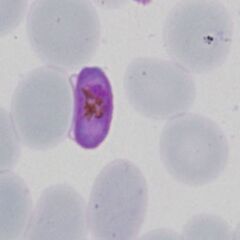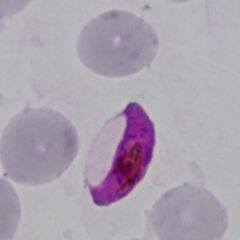P.falciparum gametocyte gallery: Difference between revisions
From haematologyetc.co.uk
No edit summary |
No edit summary |
||
| Line 12: | Line 12: | ||
<span style="font-size:95%">'''Summary'''</span> | <span style="font-size:95%">'''Summary'''</span> | ||
<span style="font-size:95%">Gametocytes in this species are highly distinctive. They develop within the red cell as long rods, however the red cell membrane continues to restrict them - the haemoglobin is fully metabolised so is not visible, but the residual membrane of the red cell "ghost" can usually be seen to the side of the red cell. The gametocytes differ with large (macrogametocyte) forms that become curved because of the red cell membrane restricting thir shape (banana form); the smaller (microgametocytes) retain the rod shape. | <span style="font-size:95%">Gametocytes in this species are highly distinctive. They develop within the red cell as long rods, however the red cell membrane continues to restrict them - the haemoglobin is fully metabolised so is not visible, but the residual membrane of the red cell "ghost" can usually be seen to the side of the red cell. The gametocytes differ with large (macrogametocyte) forms that become curved because of the red cell membrane restricting thir shape (banana form); the smaller (microgametocytes) retain the rod shape. In each case the gold/brown pigment overlies the chromatin area | ||
---- | ---- | ||
Revision as of 10:58, 21 March 2024
Navigation
Go Back
|


